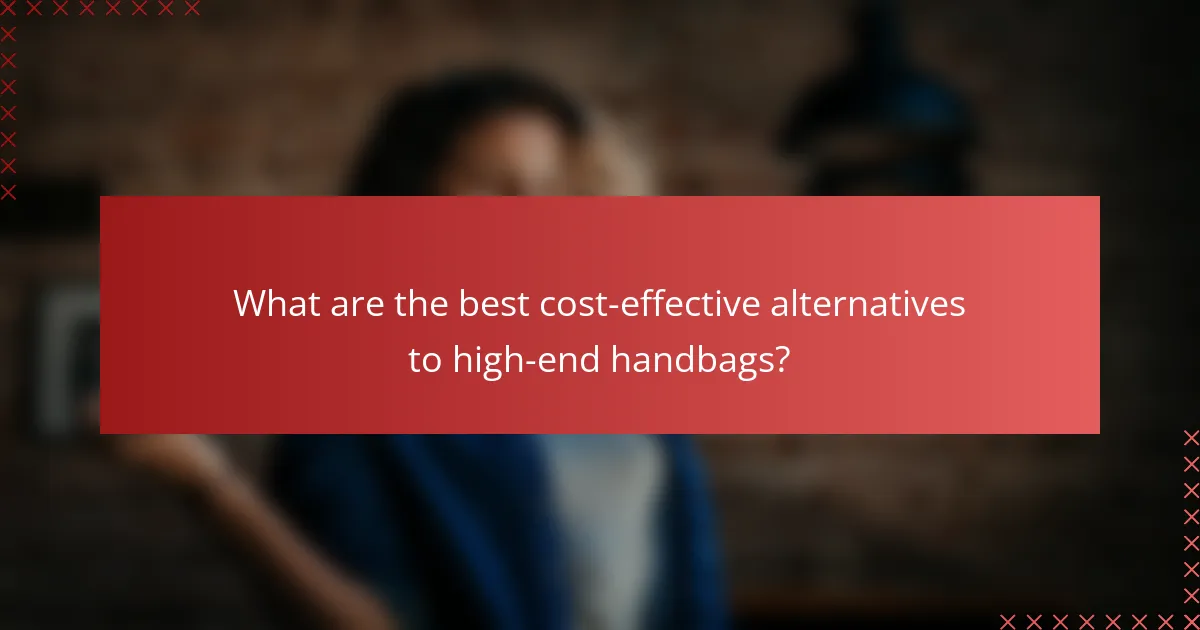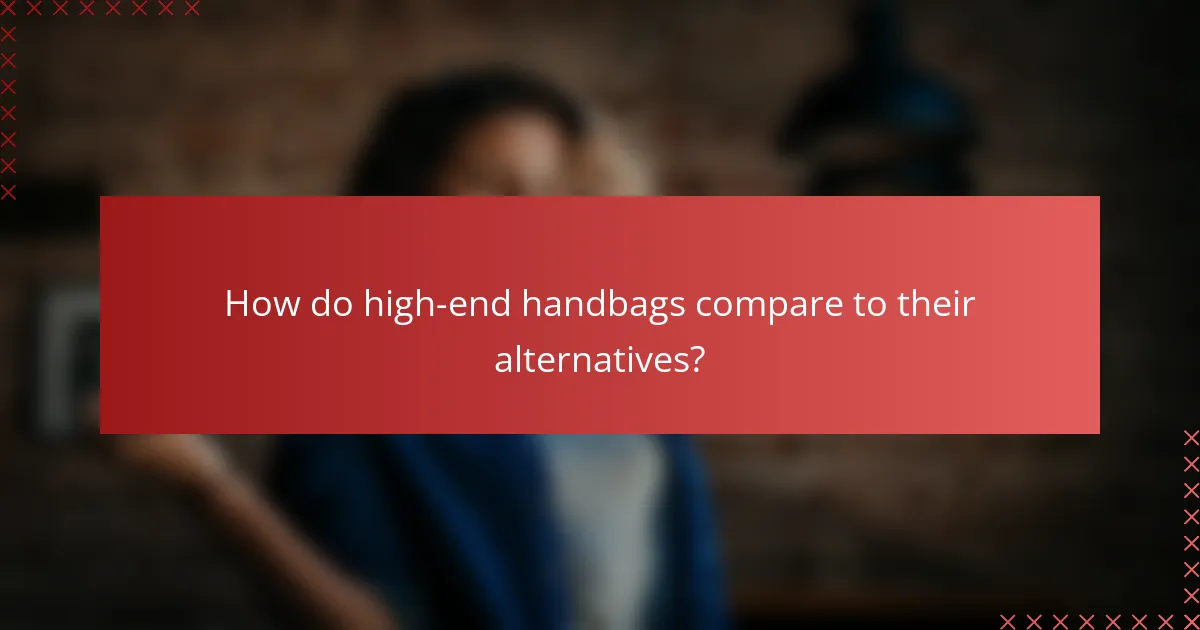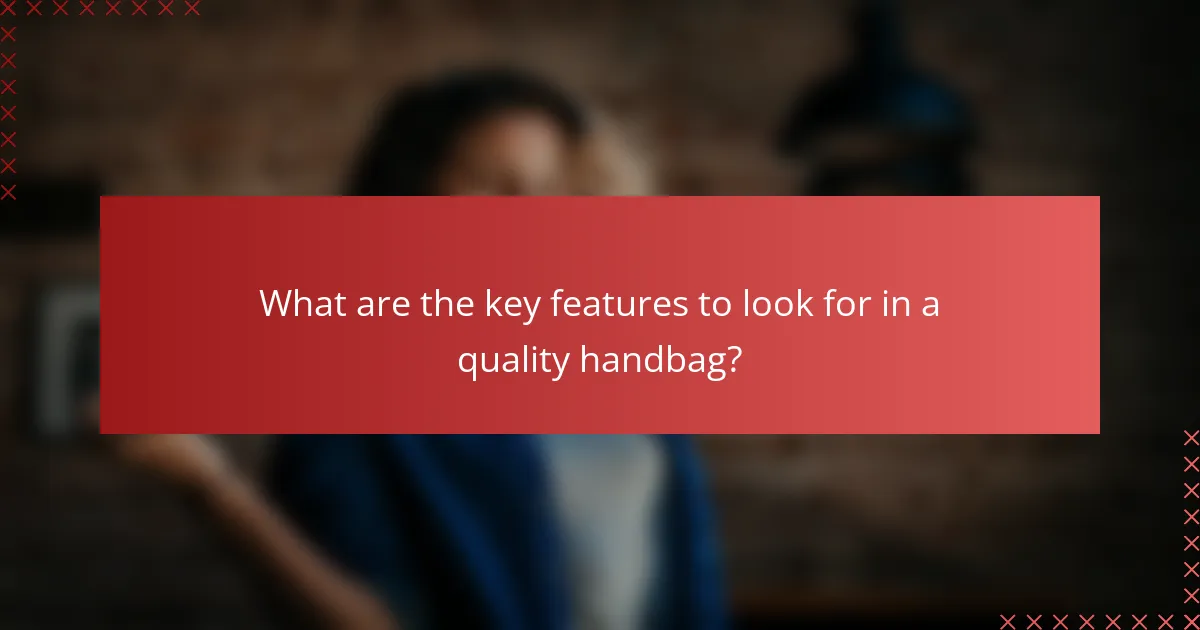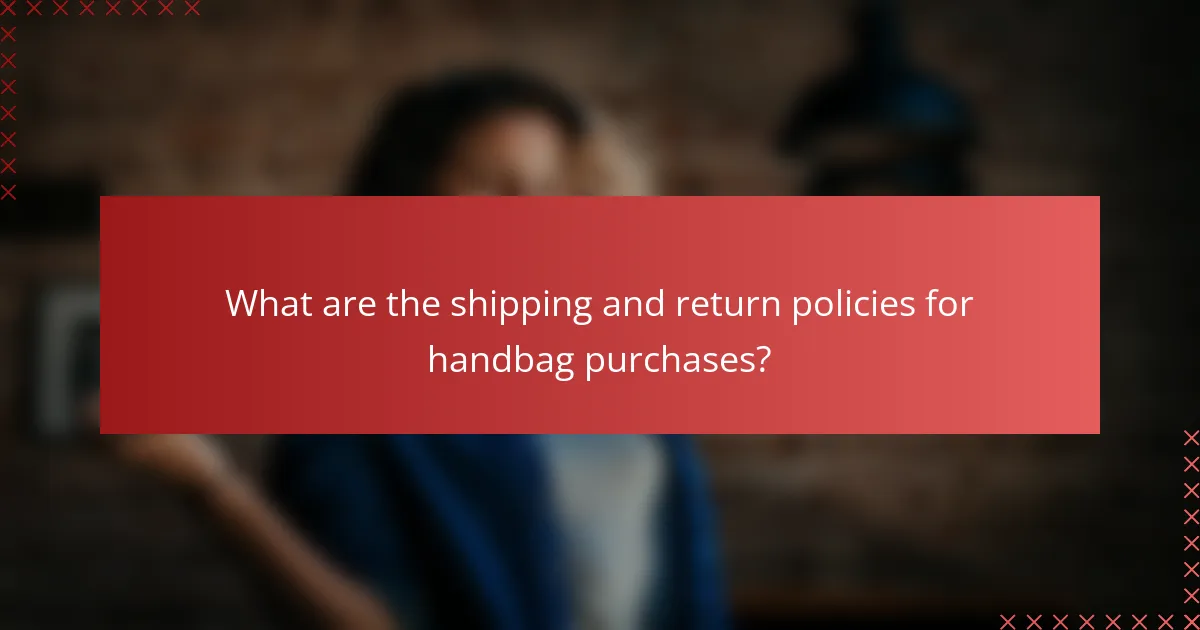High-end handbags are often coveted for their craftsmanship and prestige, but cost-effective alternatives can offer similar style and functionality without the steep price. From designer-inspired brands to high-quality replicas, consumers can find options that prioritize durability and aesthetics. By focusing on key features such as material, stitching, and brand reputation, shoppers can make informed choices that balance quality and affordability.

What are the best cost-effective alternatives to high-end handbags?
Cost-effective alternatives to high-end handbags include designer-inspired brands, luxury replicas, and high-quality materials at lower price points. These options provide style and durability without the hefty price tag associated with luxury labels.
Designer-inspired brands
Designer-inspired brands offer stylish handbags that mimic the look of high-end designs at a fraction of the cost. Brands like Michael Kors, Kate Spade, and Tory Burch often feature trendy styles and quality craftsmanship, making them popular choices for budget-conscious shoppers.
When choosing designer-inspired options, look for brands that prioritize quality materials and construction. This ensures that your handbag not only looks good but also lasts longer, providing better value for your investment.
Luxury replica options
Luxury replica handbags are designed to closely resemble authentic high-end pieces, often at significantly lower prices. While some replicas can be of high quality, it’s essential to purchase from reputable sellers to avoid counterfeit products.
Be aware of the legal implications of buying replicas, as some countries have strict regulations against counterfeit goods. Always check reviews and ratings of sellers to ensure you are getting a legitimate product.
Affordable high-quality materials
Handbags made from affordable yet high-quality materials, such as vegan leather or durable canvas, can be excellent alternatives to luxury options. Brands like Fossil and Matt & Nat focus on sustainability while offering stylish designs that stand the test of time.
When selecting a handbag, consider the material’s durability and ease of maintenance. Look for features like water resistance and stain resistance to ensure your bag remains in good condition over time.
Second-hand luxury marketplaces
Second-hand luxury marketplaces, such as The RealReal and Poshmark, allow you to purchase authentic high-end handbags at reduced prices. These platforms often feature gently used items that have been authenticated, providing peace of mind with your purchase.
When shopping second-hand, carefully review the condition of the handbag and ask for detailed photos if needed. This helps ensure you know exactly what you’re getting and can avoid any unpleasant surprises.
Local artisan creations
Local artisans often create unique handbags that combine quality craftsmanship with distinctive designs. Supporting local businesses can lead to finding one-of-a-kind pieces that stand out from mass-produced options.
Explore local markets or online platforms like Etsy to discover artisan-made handbags. This not only supports small businesses but also allows you to own a handbag that reflects your personal style and values.

How do high-end handbags compare to their alternatives?
High-end handbags often stand out due to their superior craftsmanship, brand recognition, and quality materials, but there are many cost-effective alternatives that can provide similar aesthetics and functionality. Understanding the differences in quality, prestige, price, and durability can help consumers make informed choices.
Quality of materials
High-end handbags typically use premium materials such as full-grain leather, exotic skins, and high-quality hardware, which contribute to their luxurious feel and appearance. In contrast, alternatives may utilize synthetic materials or lower-grade leather, which can affect the overall look and longevity of the bag.
When considering alternatives, look for brands that prioritize sustainable materials and ethical production practices. Some mid-range brands offer bags made from high-quality vegan leather or responsibly sourced materials that can rival the look and feel of luxury handbags.
Brand prestige
Brand prestige plays a significant role in the appeal of high-end handbags, often associated with exclusivity and status. Luxury brands invest heavily in marketing and heritage, which enhances their desirability among consumers.
However, many emerging brands are gaining recognition for their unique designs and quality craftsmanship without the hefty price tag. Supporting these brands can provide a sense of individuality while still achieving a fashionable look.
Price differences
The price of high-end handbags can range from several hundred to several thousand dollars, depending on the brand and materials used. In contrast, cost-effective alternatives typically range from around $50 to a few hundred dollars, making them more accessible to a wider audience.
When shopping for alternatives, set a budget and explore various brands. Look for sales, discounts, or outlet options to find quality handbags at reduced prices without compromising on style.
Durability and longevity
High-end handbags are often designed for longevity, with meticulous attention to detail and robust construction methods that ensure they withstand daily use. Many luxury bags can last for years, even decades, if properly cared for.
Cost-effective alternatives may not always offer the same durability, but some brands focus on creating long-lasting products. Check reviews and material specifications to find options that balance affordability with durability, ensuring your investment lasts as long as possible.

What are the key features to look for in a quality handbag?
When selecting a quality handbag, focus on material, stitching, brand reputation, and functional design. These features significantly influence durability, style, and overall value.
Material types
The material of a handbag is crucial for its longevity and appearance. Common high-quality materials include genuine leather, suede, and durable synthetic fabrics. Each type has its pros and cons; for instance, leather offers a classic look but requires maintenance, while synthetic options can be more affordable and easier to care for.
When assessing materials, consider the handbag’s intended use. For everyday wear, look for water-resistant or easy-to-clean options, while for special occasions, finer materials may be more appropriate.
Stitching quality
Stitching quality is a key indicator of a handbag’s craftsmanship. Look for even, tight stitches that are not fraying or loose. High-quality handbags often feature double stitching in stress areas to enhance durability.
Inspect the seams and edges; they should be neatly finished without any visible threads. A well-stitched handbag will withstand daily use and maintain its shape over time.
Brand reputation
Brand reputation plays a significant role in the perceived quality of a handbag. Established brands often have a history of quality craftsmanship and customer satisfaction, which can provide peace of mind when making a purchase.
Research customer reviews and ratings to gauge the brand’s reliability. Brands known for their quality typically offer warranties or guarantees, which can be an added benefit.
Functional design
A handbag’s functional design is essential for practicality. Consider features such as pocket organization, strap length, and closure types. A well-designed handbag should meet your daily needs, whether for work, travel, or casual outings.
Evaluate the size and weight of the handbag as well. It should be comfortable to carry and appropriately sized for your essentials. Look for adjustable straps and multiple compartments to enhance usability.

Where can I find high-quality alternatives online?
You can find high-quality alternatives to high-end handbags online through various platforms that specialize in affordable yet stylish options. These alternatives often provide similar aesthetics and craftsmanship at a fraction of the cost, making luxury accessible to a broader audience.
Popular e-commerce platforms
Major e-commerce platforms like Amazon, eBay, and Etsy offer a wide range of handbag alternatives. You can filter by price, material, and customer reviews to find options that suit your style and budget.
When shopping on these platforms, look for sellers with high ratings and positive feedback to ensure quality. Many listings include detailed descriptions and images, helping you make informed decisions.
Specialty handbag retailers
Specialty retailers such as Michael Kors, Kate Spade, and Coach often have outlet sections on their websites where you can find discounted handbags. These retailers focus on quality and design, providing stylish options that mimic high-end brands without the hefty price tag.
Additionally, brands like Fossil and Rebecca Minkoff offer trendy designs at lower price points, making them great alternatives. Keep an eye on seasonal sales for even better deals.
Luxury consignment shops
Luxury consignment shops like The RealReal and Poshmark specialize in pre-owned designer handbags. These platforms allow you to purchase authentic luxury items at reduced prices, often in excellent condition.
When buying from consignment shops, check for authentication guarantees and return policies. This ensures you receive a genuine product while enjoying significant savings compared to retail prices.
Social media marketplaces
Social media platforms like Instagram and Facebook have become popular marketplaces for buying and selling handbags. Many sellers showcase their products through posts and stories, allowing you to find unique pieces directly from individuals.
Be cautious when purchasing through social media; always verify the seller’s credibility and request additional photos if needed. Look for established accounts with positive reviews to minimize risks.

What are the shipping and return policies for handbag purchases?
Shipping and return policies for handbag purchases can vary significantly by retailer. Most high-end brands offer standard shipping options and specific return windows, which are crucial to understand before making a purchase.
Standard shipping options
Standard shipping typically includes a range of delivery methods, from economy to expedited options. Many retailers provide free standard shipping on orders over a certain amount, often in the range of $100 to $200. It’s advisable to check if the retailer ships internationally and what additional fees may apply.
Delivery times can vary, with standard shipping generally taking anywhere from 3 to 7 business days within the U.S. For international orders, expect longer delivery times, often between 7 to 21 business days, depending on the destination and customs processing.
Return window duration
The return window for handbag purchases usually ranges from 14 to 30 days from the date of delivery. Some retailers may offer extended return periods during holiday seasons or special promotions. Always verify the specific return policy before purchasing, as some items may be final sale and not eligible for returns.
To ensure a smooth return process, keep the original packaging and receipt. Some retailers may require items to be unworn and in original condition to qualify for a full refund.
